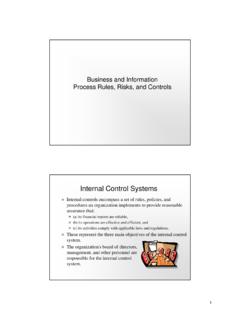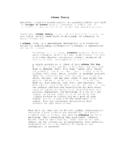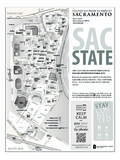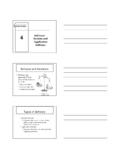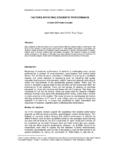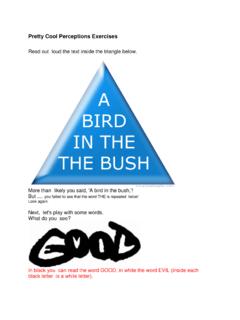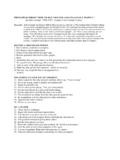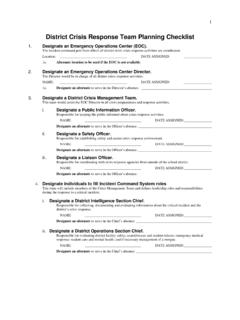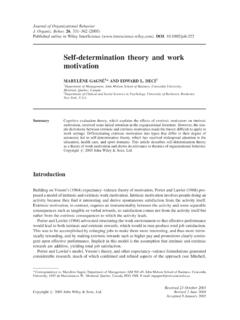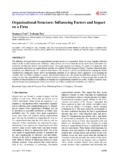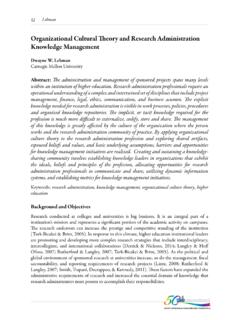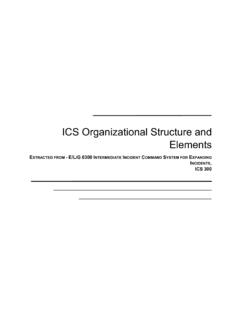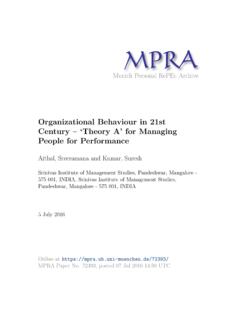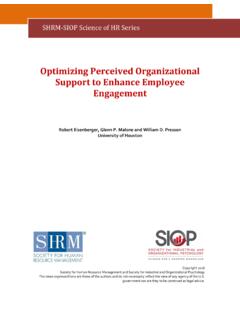Transcription of An Overview of Public Relations Theory - Sacramento State
1 Rhee, Y. (2004). The employee- Public -organization chain in relationship management: a case study of a government organization. Unpublished doctoral dissertation, University of Maryland, College Park. 16An Overview of Public Relations Theory Management Perspectives in Public Relations The field of Public Relations has progressed far from the research tradition, which primarily focused on production of messages, campaigns, and mass media effects on audiences (Bruning & Ledingham, 2000; Ledingham & Bruning, 1998). J. Grunig and Hunt (1984) have provided grounds for the re-conceptualization of Public Relations . They defined Public Relations as the management of communication between an organization and its publics (p. 7). Furthermore, J. Grunig and Hunt (1984) proposed a model of strategic Public Relations management. Their strategic Public Relations management Theory encompasses much of the foundational knowledge in Public Relations strategy, including the situational Theory of publicsTP1PT and models of Public Relations .
2 The Excellence Study Considered as a monumental study in Public Relations , the excellence study can be seen as an integration of strategic management theories of Public Relations into a greater whole. Funded by the International Association of Business Communicators (IABC) Research Foundation, a team of six researchers (J. Grunig, L. Grunig, Dozier, Ehling, Repper, and White) began their research by addressing the question posed: How, why, and to what extent does communication contribute to the achievement of organizational objectives? In addition to the original question of organizational effectiveness, they added TP1PT Developed by J. Grunig, situational Theory is a theoretical framework that allows identification of strategic publics. The situational Theory of publics consists of two dependent variables, active and passive communication behavior, and three independent variables, problem recognition, constraint recognition, and level of involvement.
3 Through combination of these dimensions, J. Grunig and Hunt (1984) found consistent types of publics, all-issue publics, apathetic publics, single issue-publics, and hot-issue publics (see J. Grunig, 1997 for an extensive review of the Theory ). Rhee, Y. (2004). The employee- Public -organization chain in relationship management: a case study of a government organization. Unpublished doctoral dissertation, University of Maryland, College Park. 17what they called the excellence question: How must Public Relations be practiced and the communication function organized for it to contribute most to organizational effectiveness? (J. Grunig, 1992a, p. 5) The IABC team first started to develop a Theory of value of Public Relations by reviewing theories of business social responsibility, ethics, and conflict resolution. They asserted that Public Relations has value to the larger society as well as to specific organizations. To further identify the value of excellent Public Relations , they examined previous research on excellence in management and searched for the meaning of organizational effectiveness.
4 The IABC team concluded that organizations are effective when they choose and achieve goals that are important to their self-interest as well as to the interests of strategic publics in their environment (L. Grunig, J. Grunig, & Ehling, 1992, p. 86). They argued that, by helping organizations build relationships and by resolving conflicts between the organization and its strategic publics, Public Relations departments contribute to organizational effectiveness. Through a combination of survey research and qualitative research, they identified 14 generic principles of excellent Public Relations , which they later consolidated into ten. The following are the ten generic principles J. Grunig and his colleagues suggested (Vercic, J. Grunig, & L. Grunig, 1996): 1. Involvement of Public Relations in strategic management. An organization that practices Public Relations strategically develops programs to communicate with strategic publics, both external and internal that provide the greatest threats to and opportunities for the organization.
5 Rhee, Y. (2004). The employee- Public -organization chain in relationship management: a case study of a government organization. Unpublished doctoral dissertation, University of Maryland, College Park. 182. Empowerment of Public Relations in the dominant coalition or a direct reporting relationship to senior management. In effective organizations, the senior Public Relations person is part of or has access to the group of senior managers with greatest power in the organization. 3. Integrated Public Relations function. All Public Relations functions are integrated into a single department or have a mechanism to coordinate the departments. Only in an integrated system of Public Relations is it possible for Public Relations to develop new communication programs for changing strategic publics. 4. Public Relations is a management function separate from other functions. Many organizations splinter the Public Relations function by making it a supporting tool for other departments such as marketing, human resources, law, or finance.
6 When the Public Relations function is sublimated to other functions, it cannot move communication resources from one strategic Public to another as an integrated Public Relations function can. 5. Public Relations unit headed by a manager rather than a technician. Communication technicians are essential to carry out day-to-day communication activities. However, excellent Public Relations units must have at least one senior communication manager who conceptualizes and directs Public Relations programs. 6. Two-way symmetrical model of Public Relations . Two-way symmetrical Public Relations is based on research and uses communication to manage conflict and improve understanding with strategic publics. Excellent Public Rhee, Y. (2004). The employee- Public -organization chain in relationship management: a case study of a government organization. Unpublished doctoral dissertation, University of Maryland, College Park. 19relations departments model more of their communication programs on this model than on the press agentry, Public information, or two-way asymmetrical models.
7 However, they often combine elements of the two-way symmetrical and asymmetrical models in a mixed-motive model. 7. A symmetrical system of internal communication. Excellent organizations have decentralized management structures that give autonomy to employees and allow them to participate in decision making. They also have participative, symmetrical systems of internal communication with employees that increases job satisfaction because employee goals are incorporated into the organizational mission. 8. Knowledge potential for managerial role and symmetrical Public Relations . Excellent programs are staffed by professionals people who are educated in the body of knowledge and who are active in professional associations and read professional literature. 9. Diversity embodied in all roles. The principle of requisite variety (Weick, 1969) states that effective organizations have as much diversity inside the organization as in the environment.
8 Excellent Public Relations includes both men and women in all roles, as well as practitioners of different racial, ethnic, and cultural backgrounds. 10. organizational context for excellence. Excellent Public Relations departments are nourished by participative rather than authoritarian cultures, activist pressure from the environment, and organic rather than mechanical management structures. (pp. 37 40) Rhee, Y. (2004). The employee- Public -organization chain in relationship management: a case study of a government organization. Unpublished doctoral dissertation, University of Maryland, College Park. 20 Over the years, the excellence Theory has been tested and supported through studies by several researchers (for example, Kaur, 1997; Rhee, 2002; Shrout, 1991; Vercic, J. Grunig, & L. Grunig, 1996). Most of its theoretical components have been extended and incorporated into the recent development of relationship management Theory .
9 In particular, the two-way models were directly applied to J. Grunig and Huang s (2000) relationship management model as maintenance strategies, which I will discuss in detail in a later section. In this study, I attempted to identify communication structures and processes important for internal and external relationship building processes. In this regard, theories of excellence that identify organizational structure for effective organizational communication provided useful insights. More specifically, principles closely related to structure, such as organization of the communication function, internal communication system, and organizational context, are relevant to this study. Although not a principle related to structure, I also included the two-way models of Public Relations principle, because it is related to the cultivation strategies for relationships. I also focused on the dominant coalition s support principle because I believe much of an organization s structure and process is greatly affected by the key decision makers of an organization.
10 In the following, I will further discuss these principles, along with recent developments in organizational psychology and organizational communication. Empowerment of Public Relations Function Dominant coalition refers to the group of senior managers who control the organization (J. Grunig, 1992a, p. 5). The excellence study maintained that because the dominant coalition makes the organization s key strategic decisions, the senior Public Rhee, Y. (2004). The employee- Public -organization chain in relationship management: a case study of a government organization. Unpublished doctoral dissertation, University of Maryland, College Park. 21relations practitioner should have a seat in top management meetings or at least direct reporting relationships to senior managers (J. Grunig, 1992a). Unless the Public Relations function is empowered by the dominant coalition and included in the strategic decision making process, it cannot enact its role as a counselor, who helps the organization to consider the issues of the organization s strategic publics (L.)
